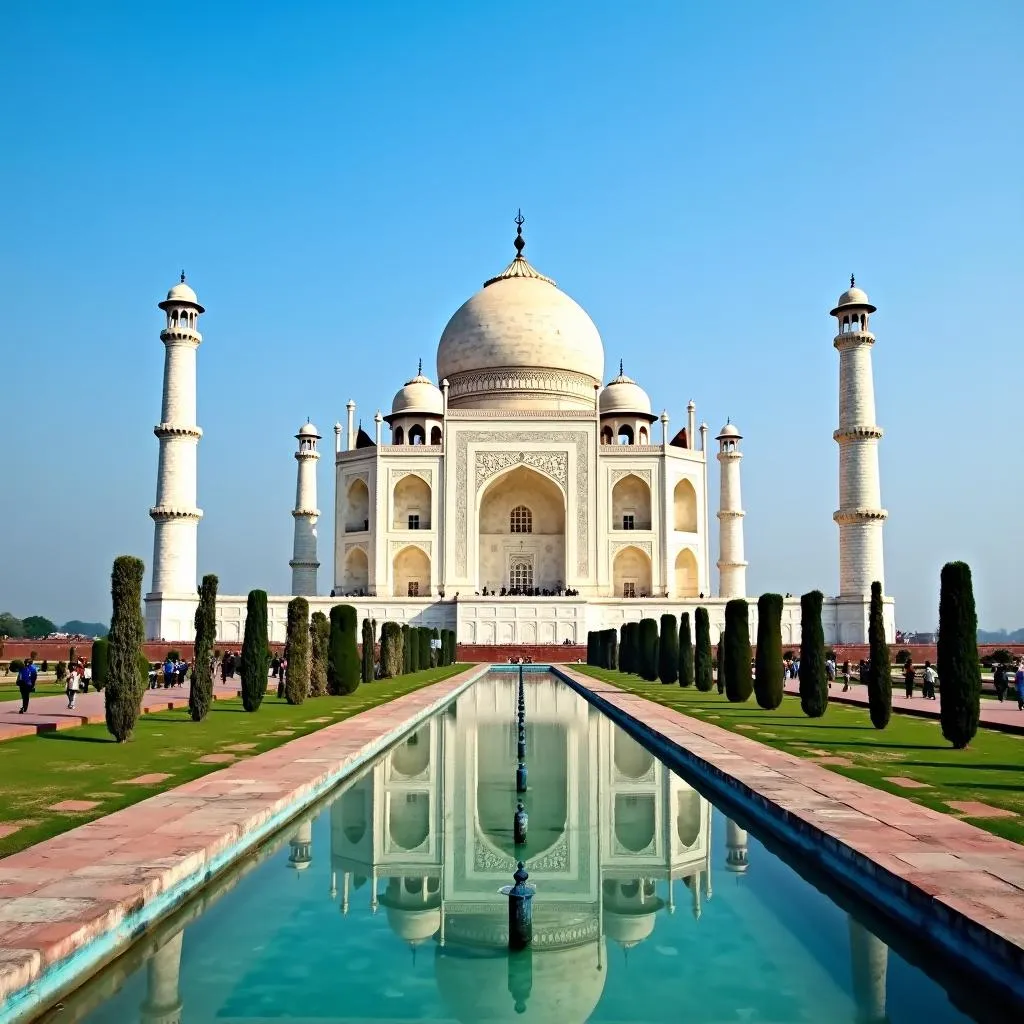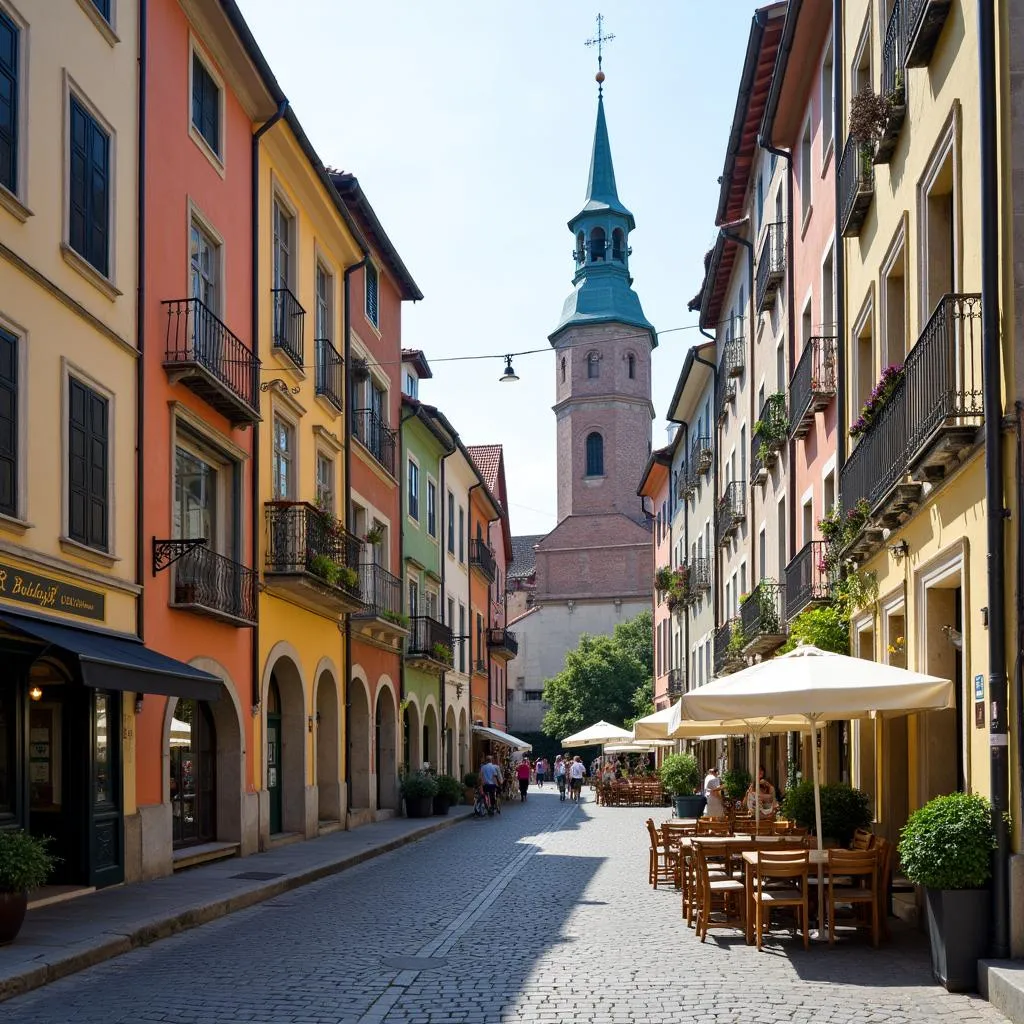When preparing for the IELTS Speaking test, one common topic that often appears is describing a historic building. This article will guide you through answering questions related to historic buildings, providing sample responses and valuable tips to help you achieve a high band score.
Describe a famous building you visited is a topic that frequently appears in IELTS Speaking Part 2. Being prepared to discuss historic buildings can significantly boost your confidence and performance during the test.
Part 1: Introduction and Interview
In Part 1, the examiner may ask general questions about buildings and architecture. Here are some common questions you might encounter:
- Are there any famous historic buildings in your hometown?
- Do you think it’s important to preserve old buildings?
- What’s your favorite type of architecture?
Let’s look at a sample answer for the first question:
Sample Answer (Band 7-8):
“Yes, there are several historic buildings in my hometown. One of the most notable is the Old Town Hall, which dates back to the 18th century. It’s a striking example of Baroque architecture with its ornate façade and grand clock tower. The building has been meticulously preserved and now serves as a museum, showcasing the city’s rich history.”
Part 2: Long Turn
For Part 2, you might receive a cue card asking you to describe a historic building. Here’s an example:
Cue Card:
Describe a historic building you have seen. You should say:
- What it is
- Where it is located
- What it looks like
- And explain why you think this building is important
Sample Answer (Band 8-9):
“I’d like to talk about the Taj Mahal, an iconic historic building I had the privilege of visiting last year. This magnificent mausoleum is located in Agra, a city in northern India, about 200 kilometers southeast of New Delhi.
The Taj Mahal is truly a breathtaking sight to behold. It’s a massive structure made entirely of white marble, with a central dome surrounded by four smaller domes. The building is symmetrical on all sides and features intricate Islamic calligraphy and floral patterns carved into the marble. The grounds around the Taj Mahal are equally impressive, with beautiful gardens and reflecting pools that create stunning mirror images of the building.
 Taj Mahal in India
Taj Mahal in India
What makes the Taj Mahal so important, in my opinion, is its historical and cultural significance. It was built in the 17th century by the Mughal Emperor Shah Jahan as a tomb for his beloved wife, Mumtaz Mahal. The building is not only a testament to the emperor’s love but also a prime example of Mughal architecture, which blends elements from Persian, Islamic, and Indian architectural styles.
Moreover, the Taj Mahal is a UNESCO World Heritage Site and is considered one of the New Seven Wonders of the World. It attracts millions of visitors each year and plays a crucial role in India’s tourism industry. The building’s enduring beauty and the story behind its construction continue to captivate people’s imaginations worldwide, making it a symbol of India’s rich history and cultural heritage.”
Follow-up Questions:
- How has the building changed over time?
- What measures are taken to preserve the building?
Sample Answers (Band 8-9):
-
“While the core structure of the Taj Mahal has remained largely unchanged, it has undergone several restoration efforts over the centuries. The most significant changes have been to protect the building from environmental damage. For instance, anti-pollution measures have been implemented to combat the yellowing of the marble caused by air pollution. Additionally, the surrounding area has been developed to accommodate the increasing number of tourists while preserving the historical integrity of the site.”
-
“The preservation of the Taj Mahal is a top priority for the Indian government and UNESCO. Several measures have been put in place, including strict air pollution controls in the surrounding area, regular cleaning of the marble using non-abrasive techniques, and limiting the number of visitors to reduce wear and tear. There’s also ongoing research into using cutting-edge technology for conservation, such as 3D scanning to monitor structural changes and develop targeted preservation strategies.”
Part 3: Two-way Discussion
In Part 3, the examiner will ask more abstract questions related to historic buildings and preservation. Here are some possible questions and sample answers:
Question 1: Why do you think some people are fascinated by old buildings?
Sample Answer (Band 7-8):
“I believe people are drawn to old buildings for several reasons. Firstly, these structures often have unique architectural features that we don’t see in modern buildings, which makes them visually interesting. Secondly, historic buildings serve as tangible links to the past, allowing us to connect with our heritage and understand how people lived in different eras. Lastly, there’s often a sense of mystery and romance associated with old buildings, which can spark our imagination and curiosity about the stories they could tell if walls could talk.”
 Historic European City Street
Historic European City Street
Question 2: Do you think it’s important for a country to invest in preserving its historic buildings? Why or why not?
Sample Answer (Band 8-9):
“Absolutely, I believe it’s crucial for countries to invest in preserving their historic buildings. These structures are not just bricks and mortar; they’re physical embodiments of a nation’s history and culture. By preserving them, we’re essentially safeguarding our cultural identity for future generations.
Moreover, historic buildings often play a significant role in tourism, which can be a major economic driver for many countries. Describe a place in your country known for its history, and you’ll likely find it’s a popular tourist destination. This tourism revenue can, in turn, fund further preservation efforts, creating a positive feedback loop.
However, it’s important to strike a balance between preservation and progress. While we should strive to maintain our architectural heritage, we also need to ensure that our cities can evolve and meet the needs of modern society. This often requires innovative solutions that integrate historic buildings into contemporary urban landscapes while respecting their original character.”
Key Vocabulary and Phrases for High Scores
To elevate your responses and aim for a higher band score, consider incorporating these advanced vocabulary items and phrases:
-
Architectural marvel (noun phrase) – /ˌɑːrkɪˈtektʃərəl ˈmɑːrvəl/ – A building that is considered exceptionally beautiful or impressive in its design and construction.
Example: “The Sagrada Familia in Barcelona is considered an architectural marvel due to its unique design and ongoing construction.” -
Meticulously preserved (adverb + past participle) – /məˈtɪkjələsli prɪˈzɜːrvd/ – Carefully and precisely maintained in its original condition.
Example: “The ancient frescoes in the Sistine Chapel have been meticulously preserved over the centuries.” -
Cultural heritage (noun phrase) – /ˈkʌltʃərəl ˈherɪtɪdʒ/ – The legacy of physical artifacts and intangible attributes of a group or society that are inherited from past generations.
Example: “The Great Wall of China is an integral part of the country’s cultural heritage.” -
Architectural significance (noun phrase) – /ˌɑːrkɪˈtektʃərəl sɪɡˈnɪfɪkəns/ – The importance of a building in terms of its design, construction, or historical context.
Example: “The Parthenon in Athens holds great architectural significance as a prime example of ancient Greek architecture.” -
Restoration project (noun phrase) – /ˌrestəˈreɪʃn ˈprɒdʒekt/ – An organized effort to repair and revitalize a building or site to its original condition.
Example: “The restoration project of Notre-Dame Cathedral in Paris began immediately after the devastating fire in 2019.”
Describe a place in your city where people go to relax often includes historic sites or buildings that have been repurposed for leisure activities. Using these advanced terms can help you discuss such topics more eloquently.
Examiner’s Advice
To excel in the IELTS Speaking test when discussing historic buildings:
-
Develop a broad knowledge base: Familiarize yourself with various historic buildings worldwide. This will allow you to speak confidently about different examples.
-
Practice describing visual details: Enhance your ability to vividly describe architectural features, colors, and styles.
-
Connect with personal experiences: Whenever possible, relate the topic to your own experiences or observations to make your answers more engaging and authentic.
-
Use a range of tenses: When discussing historic buildings, you’ll likely need to use past, present, and sometimes future tenses. Practice using these accurately and fluently.
-
Expand your vocabulary: Learn and use topic-specific vocabulary related to architecture, history, and preservation.
-
Express opinions with support: Don’t just state your views; back them up with reasons and examples.
-
Listen carefully to the questions: Ensure you address all parts of the question, especially in Part 2 where you’re given specific points to cover.
By following these tips and practicing regularly, you’ll be well-prepared to discuss historic buildings and describe an interesting place you have been to with a friend in your IELTS Speaking test. Remember, confidence comes with preparation, so invest time in developing your language skills and knowledge base.


